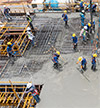As global initiatives place increased emphasis on sustainable construction and built environments, emerging priorities for building projects in nearly every industry are focused on resilience, embodied carbon reduction and achieving net-zero energy. For building owners, the challenge lies in effectively integrating sustainability and environmental, social and governance (ESG) strategies into their construction projects and long-term building operations. This integration is vital for maintaining a competitive edge, complying with evolving regulations and meeting the increasing demands of investors and stakeholders. Successfully incorporating these principles begins with defining clear sustainability scopes and objectives right from the start of a project. Renewable energy, electrification and efficient water usage are critical focus areas for sustaining operations long after construction ends.
Involve ALL Stakeholders Early
A collaborative approach helps to bridge the gap between lofty goals and practical outcomes. Architects, designers, contractors and vendors can play a pivotal role in helping owners define realistic and achievable sustainability requirements during the design phase. Early contractor involvement, which leverages the expertise of experienced teams as early as concept development and preconstruction, is vital for aligning goals, understanding costs and addressing material and equipment availability—minimizing surprises and supply chain issues down the line.
For instance, integrated design workshops that bring all parties together can be instrumental in considering the implications of design choices on both sustainability and budget. These strategic workshops often last a day or more and involve project owners, architects, engineers/designers, general contractors, subcontractors and vendors, who share their expertise and input in developing goals and specifying sustainable options as the basis of design. These strategic workshops can result in realistic, actionable objectives that spur meaningful progress. Product research should be conducted at this stage, especially for engaging supply chains to identify the right low embodied carbon materials.
Some owners and developers are even working with governmental entities as they revise and create new building and energy codes. These companies engage decision-makers early, hosting open discussions, to learn what is driving the code requirements and understand how implementation will affect project delivery. Such discussions should be approached as a partnership opportunity to improve the effectiveness not only of the design and construction process, but of the built product.
Key Considerations
Constraints related to power and water are among the most important considerations when aiming to build a net-zero building. Electrification, power grid and capacity, and water supply should be thoroughly researched during site selection. Renewable energy sources are often part of the solution and may qualify for funding or incentive packages. Design teams can also identify ways of conserving water, such as modifying equipment and outfitting it with leak detection, or configuring systems to use less water for cooling.
A collaborative approach helps to bridge the gap between lofty goals and practical outcomes.
Environmental impacts that flow from project activities should be examined as early as possible—and from as many angles as possible. The team should identify ways to reduce emissions during construction, such as by using hybrid or electric construction equipment. Supporting local economies by sourcing local materials wherever possible further enhances the environmental sustainability of a project.
Looking into supply chain logistics in conjunction with exploring design alternatives is key to managing jobsite resources, especially given current supply chain challenges. On one project, a design team explored options to replace steel elements with mass timber—a design alternative that is only available during a project’s early stages. In this example, having players across the design team involved achieved efficiencies because while contractors were performing take offs for wood from a cost perspective, the design team was able to simultaneously provide data on quantities to calculate carbon reduction.
There is increasing transparency into the embodied carbon of various materials, especially now that product category rules (PCRs) and environmental product declarations (EPDs) are being widely adopted. One development company was able to greatly reduce embodied carbon on their industrial project by switching to a different type of steel than what was originally considered.
Jobsite waste is another area receiving attention, with target numbers for reuse and waste reduction climbing higher. This makes tracking all waste generated on site important. Consistent waste tracking and landfill diversion options are often lacking, especially in rural areas, but working with haulers and recyclers can help overcome these challenges to achieve true zero waste. Designing for modular construction and reusing surplus materials are other ways to minimize waste.
Increasing the energy efficiency of finished buildings is fundamental to improving life cycle costs, especially given the potential future increase in cooling needs due to climate change. Therefore, building envelope commissioning and air-tightness testing are becoming more common practices. Another end-use consideration that should be addressed during early planning is how to restore the ecosystem surrounding a finished building to original conditions, to whatever extent possible.
The project planning phase is also the right time to focus on social responsibility. Tracking and reporting on local hiring practices and using minority businesses is a part of social governance. Additionally, health and safety considerations must be prioritized when selecting materials and construction practices.
Fostering a culture of sustainability... will improve resilience, reduce embodied carbon and achieve net-zero energy.
You Can't Manage What You Don’t Measure
Increasingly, ESG reporting requirements are being driven by investors. In fact, investors are making decisions to finance projects based on ESG-related criteria.
Tracking data is essential for driving improvements—and the task should not be left up to the busy site team. With advanced software solutions, project owners can automate the tracking of carbon emissions and other critical metrics. It’s important to note that there’s not likely to be one single tool that can scale the tracking of all sustainability metrics; a coordinated suite of solutions will be necessary. Useful tools provide the flexibility needed to adapt as reporting requirements evolve, ensuring that sustainability efforts are both effective and transparent.
While automation can reduce barriers to data collection and processing, it is nevertheless important to establish a sitewide culture of valuing sustainability. This allows the project team to take advantage of bottom-up insights and not just top-down ones.The future of sustainability in construction lies in innovation. By adopting innovative approaches and leveraging tools for tracking and reporting, building owners can ensure their projects are sustainable and compliant. While the tools don’t have to be perfect to provide value, they should be embraced wherever possible. Ultimately, fostering a culture of sustainability—where tracking, reporting and improvement are ingrained in the project workflow—is what will improve resilience, reduce embodied carbon and achieve net-zero energy.



